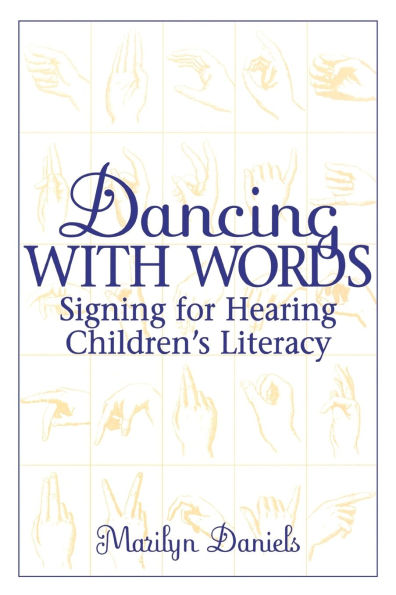Dancing with Words: Signing for Hearing Children's Literacy
One of the foremost authorities on the use of sign language with hearing children provides a guide for teachers and parents who want to introduce signing in hearing children's language development. Marilyn Daniels provides a complete explanation for its use, a short history of sign language and its primary role within the Deaf community, an identification of the steps to reading success delineated with suggestions for incorporating sign language, and finally the results of studies and reactions of children, teachers, and parents. She shows how sign language can be used to improve hearing children's English vocabulary, reading ability, spelling proficiency, self-esteem, and comfort with expressing emotions. Signing also facilitates communication, aids teachers with classroom management, and has been shown to promote a more comfortable learning environment while initiating an interest and enthusiasm for learning on the part of students.
Sign language is shown to be an effective agent to accelerate literacy in hearing children from babyhood through sixth grade. A comprehensive exploration of the physiological rationale for the educational advantage sign carries is presented. Overlapping integrated brain activities are incited by movement, vision, meaning, memory, play and the hand itself when sign language is used. Recent findings clearly indicate this bilingual approach with hearing children activates brain growth and development.
1112049092
Sign language is shown to be an effective agent to accelerate literacy in hearing children from babyhood through sixth grade. A comprehensive exploration of the physiological rationale for the educational advantage sign carries is presented. Overlapping integrated brain activities are incited by movement, vision, meaning, memory, play and the hand itself when sign language is used. Recent findings clearly indicate this bilingual approach with hearing children activates brain growth and development.
Dancing with Words: Signing for Hearing Children's Literacy
One of the foremost authorities on the use of sign language with hearing children provides a guide for teachers and parents who want to introduce signing in hearing children's language development. Marilyn Daniels provides a complete explanation for its use, a short history of sign language and its primary role within the Deaf community, an identification of the steps to reading success delineated with suggestions for incorporating sign language, and finally the results of studies and reactions of children, teachers, and parents. She shows how sign language can be used to improve hearing children's English vocabulary, reading ability, spelling proficiency, self-esteem, and comfort with expressing emotions. Signing also facilitates communication, aids teachers with classroom management, and has been shown to promote a more comfortable learning environment while initiating an interest and enthusiasm for learning on the part of students.
Sign language is shown to be an effective agent to accelerate literacy in hearing children from babyhood through sixth grade. A comprehensive exploration of the physiological rationale for the educational advantage sign carries is presented. Overlapping integrated brain activities are incited by movement, vision, meaning, memory, play and the hand itself when sign language is used. Recent findings clearly indicate this bilingual approach with hearing children activates brain growth and development.
Sign language is shown to be an effective agent to accelerate literacy in hearing children from babyhood through sixth grade. A comprehensive exploration of the physiological rationale for the educational advantage sign carries is presented. Overlapping integrated brain activities are incited by movement, vision, meaning, memory, play and the hand itself when sign language is used. Recent findings clearly indicate this bilingual approach with hearing children activates brain growth and development.
45.0
Out Of Stock
5
1

Dancing with Words: Signing for Hearing Children's Literacy
200
Dancing with Words: Signing for Hearing Children's Literacy
200Paperback(New Edition)
$45.00
Related collections and offers
45.0
Out Of Stock

Product Details
| ISBN-13: | 9780897897921 |
|---|---|
| Publisher: | Bloomsbury Academic |
| Publication date: | 10/30/2000 |
| Edition description: | New Edition |
| Pages: | 200 |
| Product dimensions: | 6.14(w) x 9.21(h) x 0.42(d) |
| Lexile: | 1240L (what's this?) |
About the Author
What People are Saying About This
From the B&N Reads Blog
